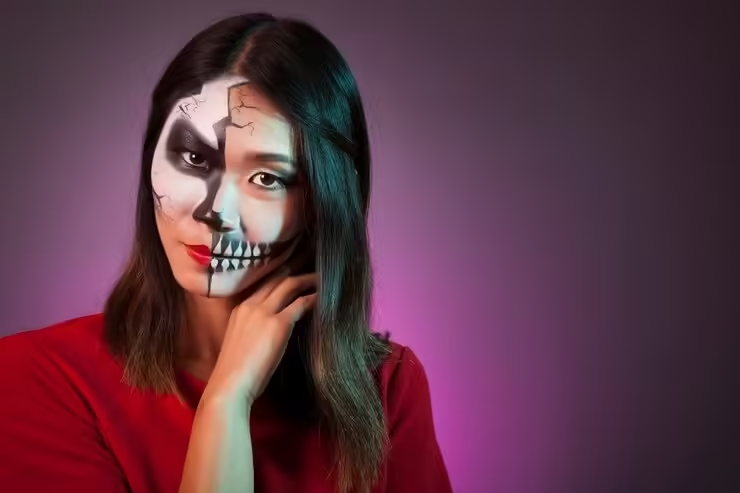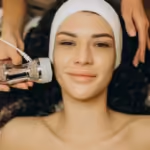In the world of film, television, and theater, the art of makeup prosthetics plays a crucial role in bringing characters to life. From the gory wounds in horror films to the fantastical creatures in fantasy series, makeup prosthetics are the backbone of many transformative looks. Whether you’re a budding artist or someone simply fascinated by the magic behind the scenes, this comprehensive guide will delve into everything you need to know about makeup prosthetics, sfx makeup, and the materials and skills that make it all possible.
Table of Contents
The Birth of Prosthetics
The history of makeup prosthetics is deeply rooted in the golden age of Hollywood. Classic films like “Frankenstein” and “The Wolfman” set the stage for modern prosthetics, with pioneering artists like Jack Pierce leading the way. These early works of classic Hollywood makeup laid the foundation for today’s sfx prosthetics, showcasing the transformative power of makeup in storytelling.
What Are Makeup Prosthetics?
Makeup prosthetics refer to the sculpting, molding, and casting techniques used to create advanced cosmetic effects that alter an actor’s appearance. This art form is essential in producing realistic or fantastical transformations, ranging from subtle changes like adding wrinkles or scars to complete transformations like turning a human actor into a non-human creature. The process involves creating and applying pre-made prosthetic pieces, which can be made from materials such as silicone, foam latex, or gelatine.
The Role of SFX Makeup in Prosthetics
SFX makeup (Special Effects Makeup) often overlaps with makeup prosthetics, as it involves the application of these prosthetic pieces to the actor’s skin. SFX makeup artists are skilled in creating the illusion of injuries, deformities, or otherworldly features that blend seamlessly with the actor’s natural skin. They use a variety of materials, including sfx cosmetics like liquid latex, to achieve these special fx prosthetics effect.
Essential Materials for Makeup Prosthetics
Creating convincing prosthetics makeup requires a deep understanding of the materials involved. Here are some of the most commonly used materials in the industry:
- Silicone: Widely used for its durability and skin-like texture, silicone is a preferred material for creating realistic prosthetics. It’s often used in combination with sfx cosmetics to color and blend the prosthetics into the actor’s skin.
- Foam Latex: This material is lightweight and flexible, making it ideal for large prosthetic pieces that need to move with the actor’s face or body.
- Gelatine: A more affordable option, gelatine is often used for small prosthetic pieces or temporary applications. It can be melted and molded easily, making it a versatile material for quick transformations.
The Process of Creating Makeup Prosthetics
The creation of makeup prosthetics involves several intricate steps, each requiring precision and skill. Here’s a breakdown of the process:
- Lifecasting: The first step in creating a prosthetic is to make a lifecast of the actor’s face or body part. This involves applying a mold material, typically silicone or alginate, to capture an exact replica of the area that will be transformed.
- Sculpting: Once the lifecast is made, the artist sculpts the desired prosthetic piece onto the lifecast using clay. This step requires a keen artistic eye, as the sculpting will determine the final look of the prosthetic.
- Molding: After the sculpting is complete, a mold is created around the sculpted piece. This mold will be used to cast the final prosthetic.
- Casting: The final step is to cast the prosthetic using materials like silicone, foam latex, or gelatine. Once the material is cured, the prosthetic piece is removed from the mold, ready for application.
Applying Makeup Prosthetics
Applying makeup prosthetics is an art in itself. The prosthetic piece must be seamlessly integrated with the actor’s skin, requiring a combination of adhesives, sfx cosmetics, and meticulous blending techniques.
- Adhesives: Skin-safe adhesives, such as Pros-Aide or silicone adhesive, are used to attach the prosthetic piece to the actor’s skin. These adhesives are designed to hold up under the rigors of filming, ensuring the prosthetic stays in place for hours.
- Blending: Once the prosthetic is attached, the edges are blended into the skin using sfx cosmetics like liquid latex or silicone. This step is crucial for creating a realistic look, as any visible edges can break the illusion.
- Coloring: Finally, the prosthetic is painted and colored to match the actor’s skin tone using alcohol-activated palettes or cream foundations. Additional details, such as scars or bruising, can be added using specialized sfx cosmetics.
How Do You Get into Makeup Prosthetics?
Getting into makeup prosthetics typically involves a combination of education, hands-on experience, and networking. Here’s how you can start:
- Education: Begin by taking courses in makeup artistry, with a focus on special effects makeup. Many schools and academies offer specialized programs in prosthetic makeup. Online courses and tutorials can also be beneficial.
- Practice: Start practicing by creating your own prosthetics using basic materials like clay, silicone, and latex. Experiment with different techniques to build your skills.
- Portfolio: Build a portfolio showcasing your work. Include photos of your prosthetic creations, both in-progress and completed, to demonstrate your abilities.
- Networking: Connect with professionals in the industry. Attend workshops, conventions, and events related to special effects makeup. Consider seeking out internships or apprenticeships with experienced special effects makeup artists.
- Experience: Gain experience by working on student films, indie projects, or theater productions. This will help you build your resume and refine your skills.
Starting in makeup prosthetics requires dedication and creativity, but with the right training and experience, you can carve out a successful career in this fascinating field.
Conclusion
As the demand for realistic and imaginative special effects continues to grow, so does the importance of makeup prosthetics and sfx makeup in the industry. By mastering these skills, you can become an essential part of the creative teams that bring stories to life on screen. If you’re working on a low-budget indie film or a big-budget blockbuster, the art of makeup prosthetics offers endless opportunities for creativity and innovation.
Whether you’re just starting or looking to expand your toolkit, finding a reliable sfx makeup shop near me is essential. These specialized stores offer a wide range of products, from sfx cosmetics to mold-making supplies and special fx makeup books, ensuring you have everything you need to bring your creative visions to life. Additionally, attending workshops or classes taught by experienced special effects makeup artists near me can provide hands-on experience and valuable insights into the industry.
Ready to explore the world of makeup prosthetics? Discover the latest tools and products at Health & Beauty and start creating your masterpiece today!
Frequently Asked Questions (FAQs)
How Much Does Prosthetic Makeup Cost?
The cost of prosthetic makeup can vary widely depending on the complexity of the design, the materials used, and the expertise of the artist. For simple prosthetics like scars or small wounds, prices can start as low as $100 to $300. However, more complex designs, such as full facial or body transformations, can range from $3,000 to $10,000 or even more. In the film and television industry, creating custom prosthetics for a major production can cost anywhere from $10,000 to $50,000 or higher, depending on the intricacy and scale of the project.
What Is Prosthetic Makeup Called?
Prosthetic makeup is also commonly referred to as special makeup effects, FX prosthetics, or simply prosthetics. It involves the use of sculpting, molding, and casting techniques to create prosthetic pieces that are applied to the actor’s body to alter their appearance. These effects can range from subtle enhancements to complete character transformations.
Can You Put Makeup on Prosthetics?
Yes, you can put makeup on prosthetics. In fact, applying makeup to prosthetic pieces is an essential part of the process. SFX cosmetics like alcohol-activated palettes, cream foundations, and setting powders are used to blend the prosthetic seamlessly with the actor’s skin and to add realistic details, such as skin tones, veins, scars, and other textures. Proper application of makeup on prosthetics helps create a cohesive and believable look that matches the character’s design.


